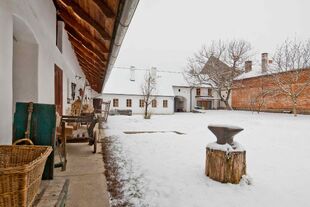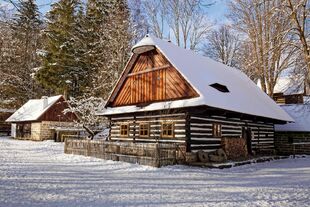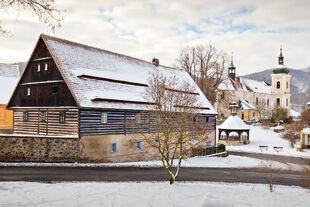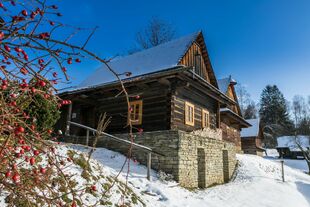The History and Foundation of the Museum
The history of the museum
The Vysočina Open Air Museum, which was known as the Vysočina Collection of Vernacular Houses until 2018, is one of the leading open air museums of vernacular architecture in the Czech Republic. It is the largest establishment of its type in Bohemia.
PhDr. Jaroslav Herout drew attention to the extraordinary scope of valuable historical buildings in the village Vysočina in the Hlinsko area in the middle of the 1960s. At the same time, Luděk Štěpán, founder of the museum, began the first surveys devoted to becoming better acquainted with the wealth of vernacular architecture in this region. He conceived the idea of establishing an exhibition of vernacular architecture in Veselý Kopec. The first interior – the weaver’s parlour in the original homestead no. 4 – was opened in 1972. Other buildings typical of the Bohemian-Moravian Highlands then began to be brought to the site and renovated.
The vernacular architecture area in Veselý Kopec gradually grew in popularity among visitors in the years to come. It terms of visiting attendance, it now ranks among the most popular sites in the Pardubice Region and in the country as a whole.
In 1993 the museum expanded to take in another site – what is now the vernacular architecture conservation area Betlém in Hlinsko. The conservation area boasts a unique collection of primarily timbered houses from the 18th and 19th centuries lying in the middle of Hlinsko that had been threatened with complete destruction. The first of these buildings were documented as long ago as 1731. Thankfully, the idea of preserving this extraordinary site for future generations prevailed at the end of the 1980s. The Vysočina Open Air Museum was entrusted with the conservation work. The first buildings in Betlém in Hlinsko were opened to visitors in 1993.
Vysočina Open Air Museum now manages and offers tours of relocated works of vernacular architecture (principally the Veselý Kopec exhibition site) and buildings preserved on their original site (the Betlém conservation area in Hlinsko).
About Betlém
You can find the vernacular architecture conservation area known as Betlém on the right bank of the River Chrudimka in Hlinsko. Timbered houses began to be built here by small craftsmen in the middle of the 18th century. The cadastral map from 1839 shows that builders built one timbered house next to another, with barely any room even for a small front garden. The craft originally predominating among the local population was pottery, though weaving came to predominate at the end of the 19th century. Those living and working here also included tailors, furriers, toymakers, saddlers and shoemakers, as well as a grocer, a barber and a midwife.
Betlém became home to families of factory workers at the end of the 19th century and, in particular, in the first third of the 20th century. It is something of a miracle that this part of Hlinsko retained its original character until the nineteen eighties. At least some of these buildings were preserved in 1987 thanks to the efforts of heritage conservationists and many other enthusiasts. Betlém became part of the Vysočina Collection of Vernacular Houses, now the Vysočina Open Air Museum, in 1989. The first renovated houses were opened to visitors in 1993, and in 1995 part of Betlém in Hlinsko was declared a conservation area. The renovation work was completed thanks to the project Revitalisation of the Vernacular Architecture Conservation Area Betlém co-financed by the Regional Operational Programme Northeast in 2012.
You can take a look at the homes and workshops of a weaver, a toymaker, a shoemaker, a file-maker and a factory worker in the timbered cottages that are open to the public. You can also find a permanent exhibition about the village Shrovetide door-to-door processions and masks from the Hlinsko area, which are part of UNESCO’s world heritage, in one of the timbered cottages. These exhibitions are open all year round, and schools can also take advantage of special programmes, collectively known as Living History, throughout the year. In addition to the cottages with the given exhibitions, you can also visit a working weaving workshop in Betlém making chenille shawls and other hand-woven accessories, a restaurant, a café, herbs shop or a musical instrument store.
About Veselý Kopec
Veselý Kopec is a charming place on the dividing line between the Iron Mountains and the Žďárské Hills. A number of buildings were brought here from the 1970s onwards from part of the region known as Czech Horácko. The only building standing on its original site is the Pilný homestead (house no. 4), which is one of the oldest examples of vernacular architecture in the Iron Mountains. The local timbered houses give an insight into the lives and work of small farmers from the middle of the 19th century to the middle of the 20th century.
There is also a remarkable collection of water-driven technical structures in Veselý Kopec, including a mill with a plum jam making room and a grain crusher, a bark mill, an oil press and a sawmill. These buildings are arranged around the original millrace built in Veselý Kopec in the 19th century. The polygonal (fourteen-sided to be exact) barn relocated from Sádek near Polička is another remarkable building. It was built on its original site in 1684.
Veselý Kopec open air museum is the venue for a great many programmes on various aspects of folk culture. Its popular events include demonstrations of folk customs (Shrovetide Procession, spring and Christmas customs) and demonstrations of crafts, traditional foods and the processing of agricultural crops. Special programmes for families with children are also held here. All visitors to Veselý Kopec can enjoy the original landscape that has been preserved at this place.













